Hot Air and High Winds: A Love Letter to the Fantasy Airship
High Fantasy.
There's a joke that does the rounds on Twitter every so often that somewhere around 2015 or 2016 we slipped into an alternative timeline. One of the bad ones where your cuddly best mate wears an eyepatch and jackboots and everyone's suddenly got sinister facial hair. This would, in a way, be a comforting notion, except that it can easily be disproved with one simple look to the sky. If this really were a parallel world, even one of the bad ones, the sky would be filled with the silent, graceful shapes of airships gliding serenely back and forth. Nothing says 'parallel universe' like an airship. From Fringe to Doctor Who, from Wolfenstein to Bioshock Infinite, if you want people to know they're on the path not taken, bung a Zeppelin in the sky and, to be honest, you may not even need the evil goatees.
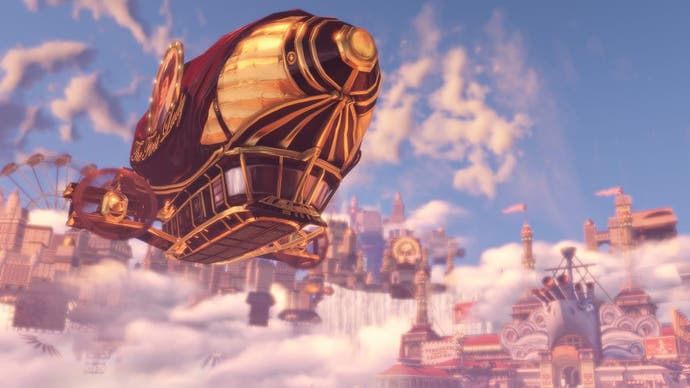
I've had a bit of a thing for airships since I was in my teens. I loved - and love - all airships, but it was the great steampunk contraptions of wood and cloth and wrought iron that had me most under their spell. Where the 'ship' is taken literally and a creaking old galleon is slung implausibly and enchantingly beneath bulging balloons. Games love them too - they're most associated with JRPGs, although I think it must have been in Super Mario Bros 3 that I first encountered them. But the airship that really sparked my love affair was in a much more obscure place. Does anyone remember the Fantastic Worlds expansion pack for Civilization 2? Anyone remember the airship units? I do. For some reason that unit captivated me. I loved it, in all its tiny, pixellated glory. I couldn't find a picture of it. Sorry. Take my word for it, though: that was a good airship.

The history of fantasy flying machines goes back further than you might think. Both the ancient Greek playwright Euripides and the historian Herodotus give the vengeful sorceress Medea a flying chariot drawn by dragons, which she uses to escape Athens after murdering her children.
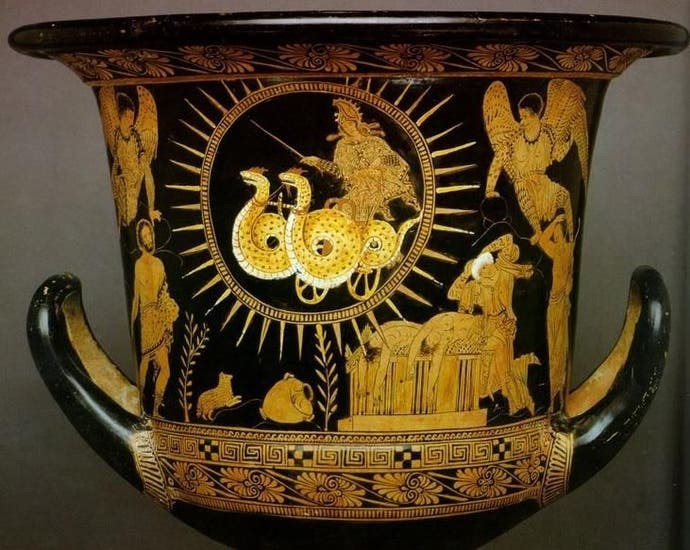
By the early first millennium AD, the assortment of tall tales that had grown up around Alexander the Great gave him a variety of fantastical vehicles and devices appropriate for a globetrotting, monster-fighting hero. As well as a submarine used for fighting sea-monsters in Alexandria's harbour, he was also reputed to have constructed a flying machine powered by griffins, which he used to travel high into the sky and look down on the earth below, before becoming scared and hurriedly returning to terra firma. The Russian folk-tale 'The Fool and the Flying Ship' gets us closer to the familiar steampunk airship we're familiar with. In 1894 this was printed for British audiences in The Yellow Fairy Book, one of Andrew Lang and Leonora Alleyne's popular series of children's fairy-tale collections.
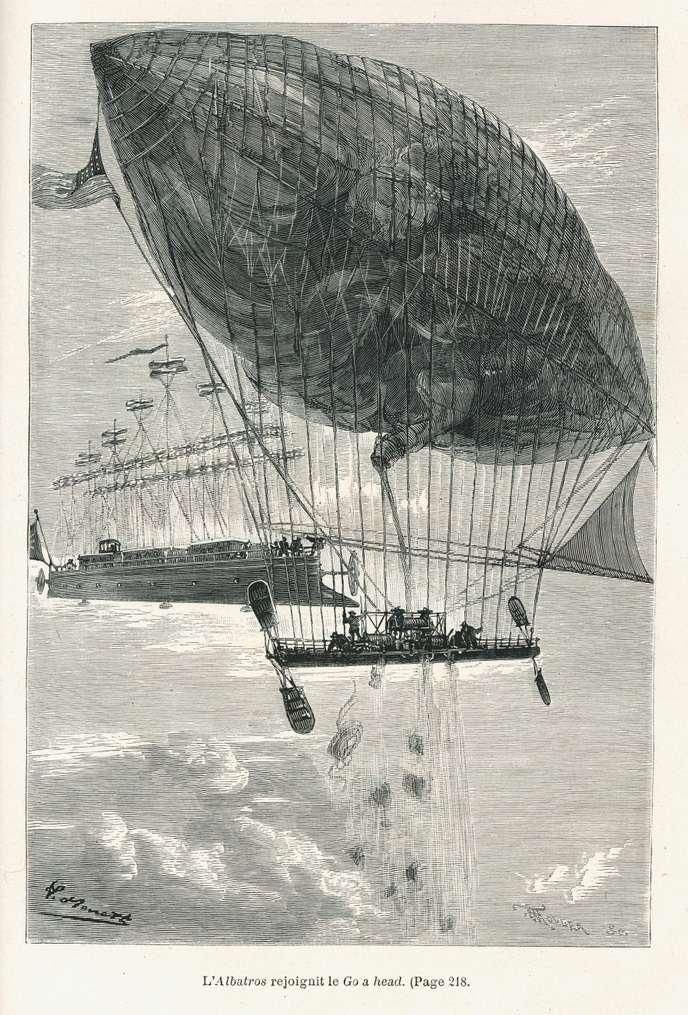
Unsurprisingly, the nineteenth century is when things really hot up for fantasy airships. The first hot-air balloon flight had occurred at the end of the eighteenth century, the novel was finding its feet as a literary genre and fantasy for both children and adults was everywhere. We often think of Jules Verne when we consider steampunk vehicles and Victorian science fiction-fantasy, and he certainly did offer his share of airships - notably in 1886's Robur-le-Conquérant. But Verne was only one of a long list of late Victorian and Edwardian writers excited by the dawning of the age of flight. Another Frenchman, the journalist and pioneer of science-fiction illustrator Albert Robida, is particularly fun. His imagined future in 1882's Le vingtième siècle and its sequels offers future-Parisian skylines filled with airships.
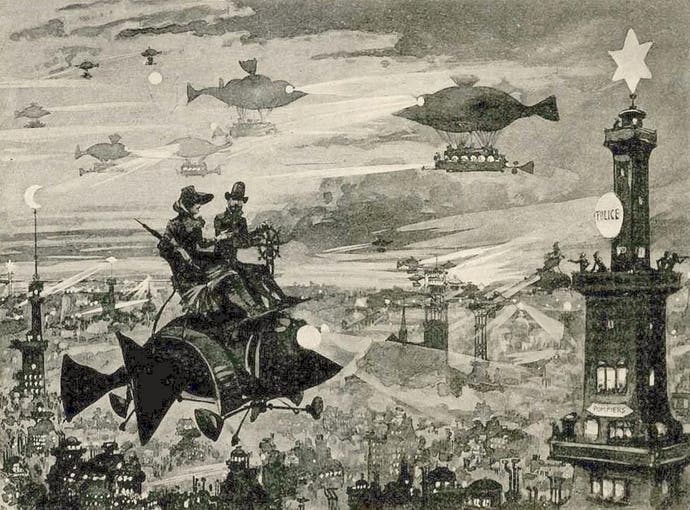
Of course, the nineteenth and early twentieth centuries also saw the hydrogen-fuelled rise of the real airship. In 1875 Jean-Pierre Blanchard crossed the Channel in a powered balloon with flapping wings and there was a failed attempt to build a military blimp as early as 1812 to defend Russia against Napoleon's invading armies. By the end of the century several successful flights had been made by motorised dirigibles, and the beginning of the twentieth century marked the beginning of the age of the Zeppelin.
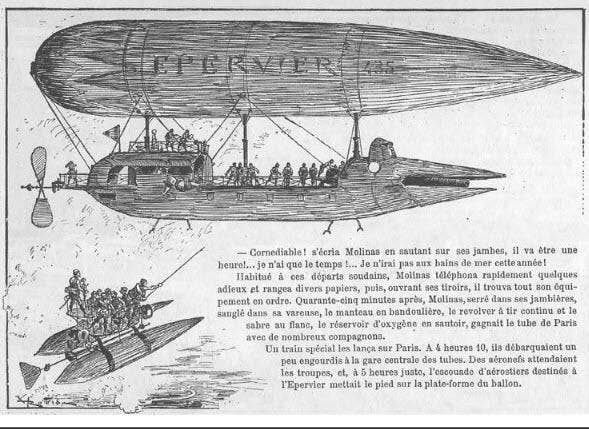
We all know how that ended up.
The Hindenburg Disaster and the conspicuous failure of the commercial airship cemented its position in the world of fantasy and alternative history. For a few decades airships plied the skies, demonstrating their near-viability, but when all that was cut short the airship never had the opportunity to become a mundane part of our everyday lives. Not only that, but the imagery of the flames licking around the Hindenburg's swastika-emblazoned tail meant those mighty Zeppelins remained inextricably linked with the Nazis, who were soon to become their own staple of the alternative history genre. Two roads not taken intertwined in popular imagination. It's no surprise, then, that the rigid dirigible, the realistic Zeppelin-style airship, tends to be associated in popular culture with timelines where something's gone awry, with totalitarian rule and military might.
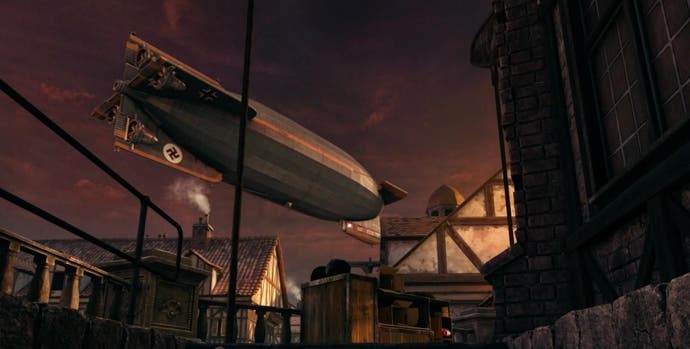
Even before the rise of the Nazis, though, the airship lost its innocence in the First World War, when Zeppelins took part in German bombing of European cities. When games and other media have wanted to portray the airship as a force for good, associated with optimism, adventure, freedom and exploration, they've tended to focus on the fantastical whimsy of Victorian and Edwardian fiction, before harsh reality came along and ruined everything. It's worth remembering that in the 80s and early 90s, when video games were coming of age, real airships would still have been within living memory of many older people. But their fictional counterparts were safely in the world of historical literature, abstracted from the mundane world as much by time and the passing of generations as by their intrinsic fictionality.
A lot of this early airship fiction comes from Europe, especially France. But video games - and their love affair with the airship - blossomed in Japan. We probably shouldn't underestimate the importance of Hayao Miyazaki and his Studio Ghibli films in bringing airships - and the 'sky-fi' sub-genre in general - to Japanese audiences at a critical juncture. 1984's Nausicaä of the Valley of the Wind features airships that are effectively gigantic planes, their aesthetic drawing heavily on the technology of the first half of the twentieth century in a way that's now often called dieselpunk. Even more influential is 1986's Laputa: Castle in the Sky. As well as more dieselpunk aircraft, we now have a wonderful array of airships. From Zeppelin-like liners to grim military dreadnaughts and ramshackle pirate ships of cloth, wood and whimsy.
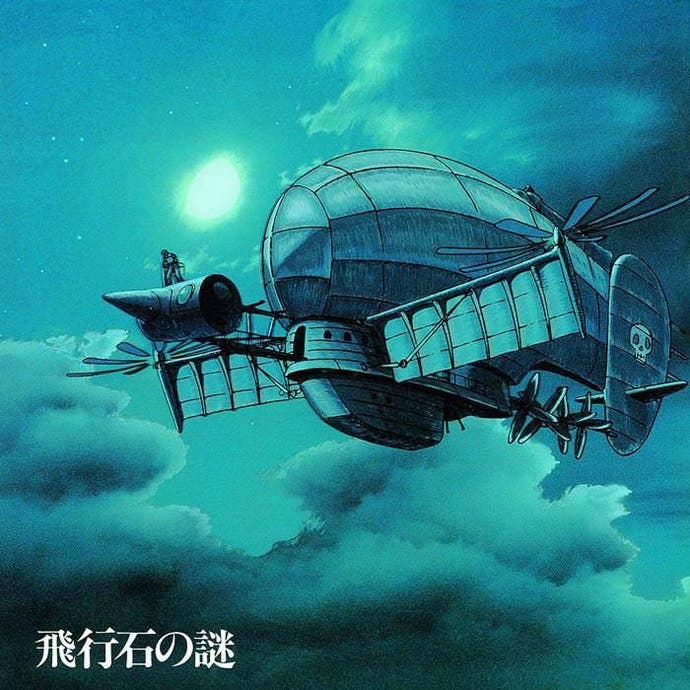
These are the roots of the Mario airships, the Fantastic Worlds one, and the skyborne galleons of Skies of Arcadia. No series is more associated with this approach than the Final Fantasy series - especially the early entries. The first game in the series came out only a year after Laputa and the Ghibli influences are pronounced throughout 90s Final Fantasy. The airship was a staple of the series, with particularly notable appearances in 4 and 6, but its wood-and-cloth airship obsession reached its apex in the sublime Final Fantasy 9. Airships abound in this game, every one a love-letter to the fin-de-siècle fiction that inspired it. The airship-filled city of Lindblum is like Metropolis by way of Robida, a strong contender for the capital of dirigible aviation in gaming.
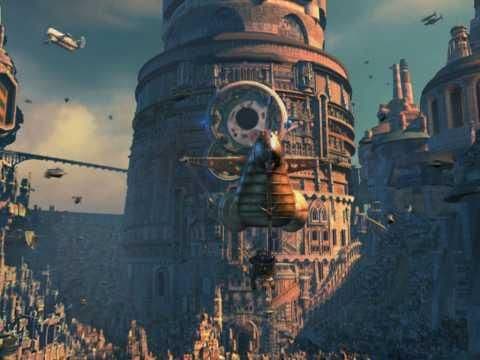
Particularly in the 80s and 90s, Japanese games' airships found their comfort zone between the two intermingled aesthetic styles evident in the Ghibli films. Victorian-flavoured wood, cloth and steam on the one hand, 1940s and 50s dieselpunk juggernauts on the other. Often the goodies tended to skew towards the former and the baddies to the latter, like in Skies of Arcadia, where you take airborne sailing ships up against airborne battleships that could have been drawn straight out of the Second World War (not an airship as such, but obviously we have to mention the influence of Space Battleship Yamato here). The boundaries were never absolute, though. The scents of wood-polish and engine oil were always mingled. And perhaps the most dieselpunk airship of them all is a hero vessel - Final Fantasy 7's Highwind, which from its gleaming aluminium hull to its glamorous pin-up nose-art, thoroughly converts the classic fantasy airship to the aesthetics of 1940s and 50s aircraft.

Barring the exuberant throwback that was Final Fantasy 9, the Highwind is something of a turning-point for Final Fantasy's airships. The traditional outline of a boat-like gondola slung below a gas-filled lifting body was still there, as were the propellers and guy-ropes. But the heroes' airship was being pushed towards something more modern. Later Final Fantasies have almost all subverted the traditional idea of the airship in some way, from the spaceships and flying universities (!) of Final Fantasy 8 to the Star Wars-influenced fighters and flying fortresses of 12. By Final Fantasy 15, the old-fashioned dirigible has been almost entirely lost in the brutalist sci-fi troop-carriers and late-game airborne concept-car that are its take on the airship idea.
That's fine, in its way. I guess there are people out there who love those for their sleek coolness. But for me, it feels a bit like something's been lost. Maybe it's because I grew up in the 90s and I'm getting to an age where, as much as I love science fiction, spaceships and the futuristic, I can't quite escape the pangs of nostalgia for the dying days of the analogue world. Nifty as exotic flying-machines held aloft by exotic glowing energy or unseen magitek are, for me they lack the sense of tangibility you get from a wooden gondola creaking precariously below a bag full of hot air. The sense of wonder and adventure to be had when you stand by the bowsprit with the headwind billowing out your greatcoat and streaming back your wonderful 90s JRPG hairdo just so. Where you can hear the chunner of a grimy old engine that runs on oil, coal and the promises of a grubby bloke with goggles and a spanner. Where an unlikely number of propellers whir to keep you aloft, and a thrilling musical theme accompanies your flight over the rolling hills and seas of the fantasy world below.

